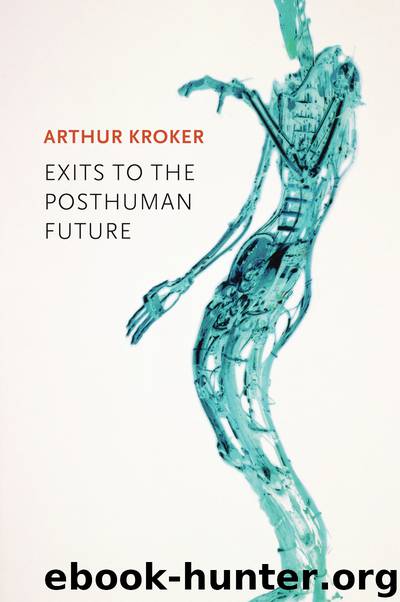Exits to the Posthuman Future by Kroker Arthur;

Author:Kroker, Arthur;
Language: eng
Format: epub
Publisher: Wiley
Published: 2013-11-07T16:00:00+00:00
In the usual way of all scientific experiments with the human body, the animal species selected for a digital eye implant is the rabbit. Definitely not mindful of Donna Haraway's understanding of animals as “companion species,” the body of the bunny is scientifically repurposed to become a platform for digital lenses. Did anyone think to ask what's a bunny's vision of the world? Or did the bunny consent to seeing fields of edible grass in a newly augmented digital way?
That the bunny was never consulted about the advantages of augmented reality is itself perhaps very revelatory of the impoverished vision of a scientist. Isn't there an indispensable ethical reflex associated with human vision, a carefully nurtured sense that human vision is not simply about appropriation, but appreciation? Strip human vision of a complex sense of critical appreciation of the world around us, and aren't we suddenly left in a world of bunnies as objects of technological appropriation, objects of abuse value?
In the larger story of technology of which this research innovation is a brilliant digital example, no permission is ever required to secure an animal's consent to a digital eye implant. Consciousness of the bunny as a unique, complex species-being is always disavowed, and this disavowal is the first, most important avowal of scientific experimentation. On the path to the augmented human eye, animals occupy the diminished role of unwilling test beds.
But, of course, not for humans. Appropriating human agency is never really required because, unlike bunnies, humans are seemingly always ready to become leading objects of digital augmentation. In response to the announcement in a story headlined “A Twinkle in the Eye,” one net correspondent immediately said: “Wow. I would be more than willing to risk losing eyesight in one of my eyes to test this out as the technology matures.” Perhaps shutting down human vision and opening up an augmented reality of the enhanced digital eye requires, in the first instance, something not really technological, but metaphysical. When the digital eye blinks for the very first time, when the augmented iris is streamed, networked, and vectored, an indispensable ethical preparation has already taken place, a prior human willingness to identify itself with its technological future with sufficient intensity to override any remaining (human) quibbles concerning animal rights, human dispositions, and what's lost with the coming-to-be of the fully realized universe of augmented reality.
In the amazing blast of technological creativity, such ethical reservations have no necessary cultural standing. How could they? Networking the eye, augmenting human vision, implies that the eye will now port information moving at light-speed. The iPhone becomes an ocular implant; texting literally becomes a blink of an eye; the cornea opens onto an iris repurposed as a mobile device. Even for those standing on the sidelines with ethical reservations ready to hand, the accidenting of the eye by digital vision can only be understood ambivalently. If individual human autobiography can be linked so intimately to the unfolding adventures of technological biography, perhaps it is because
Download
This site does not store any files on its server. We only index and link to content provided by other sites. Please contact the content providers to delete copyright contents if any and email us, we'll remove relevant links or contents immediately.
Learning SQL by Alan Beaulieu(6029)
Weapons of Math Destruction by Cathy O'Neil(5823)
Digital Minimalism by Cal Newport;(5388)
iGen by Jean M. Twenge(5156)
Sapiens by Yuval Noah Harari(5117)
The Age of Surveillance Capitalism by Shoshana Zuboff(3979)
Elon Musk by Ashlee Vance(3851)
Thing Explainer by Randall Munroe(3782)
Apollo 8 by Jeffrey Kluger(3511)
Future Crimes by Marc Goodman(3367)
The Science Book (Big Ideas Simply Explained) by DK(3131)
Who Can You Trust? by Rachel Botsman(3024)
I Live in the Future & Here's How It Works by Nick Bilton(2839)
Infinite Energy Technologies by Finley Eversole(2830)
Steve Jobs by Walter Isaacson(2758)
Dawn of the New Everything by Jaron Lanier(2686)
The Innovators: How a Group of Hackers, Geniuses, and Geeks Created the Digital Revolution by Walter Isaacson(2470)
Chernobyl by Serhii Plokhy(2434)
Energy Myths and Realities by Vaclav Smil(2377)
